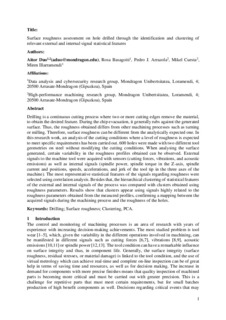Título
Surface roughness assessment on hole drilled through the identification and clustering of relevant external and internal signal statistical featuresAutor-a
Fecha de publicación
2022Versión
PostprintTipo de documento
ArtículoArtículoIdioma
InglésDerechos
© 2021 CIRPAcceso
Acceso embargadoVersión de la editorial
https://doi.org/10.1016/j.cirpj.2021.11.007Publicado en
CIRP Journal of manufacturing science and technology Vol. 36. Pp. 143-157, 2022Editorial
ElsevierPalabras clave
DrillingSurface Roughnes
Clustering, PCA
Resumen
Drilling is a continuous cutting process where two or more cutting edges remove the material, to obtain the desired feature. During the chip evacuation, it generally rubs against the generated surface ... [+]
Drilling is a continuous cutting process where two or more cutting edges remove the material, to obtain the desired feature. During the chip evacuation, it generally rubs against the generated surface. Thus, the roughness obtained differs from other machining processes such as turning or milling. Therefore, surface roughness can be different from the analytically expected one. In this research work, an analysis of the cutting conditions where a level of roughness is expected to meet specific requirements has been carried out. 600 holes were made with two different tool geometries on steel without modifying the cutting conditions. When analysing the surface generated, certain variability in the roughness profiles obtained can be observed. External signals to the machine tool were acquired with sensors (cutting forces, vibrations, and acoustic emissions) as well as internal signals (spindle power, spindle torque in the Z-axis, spindle current and positions, speeds, accelerations, and jerk of the tool tip in the three axes of the machine). The most representative statistical features of the signals regarding roughness were selected using correlation analysis. Besides that, the hierarchical clustering of statistical features of the external and internal signals of the process was compared with clusters obtained using roughness parameters. Results show that clusters appear using signals highly related to the roughness parameters obtained from the measured profiles, confirming a mapping between the acquired signals during the machining process and the roughness of the holes. [-]
Sponsorship
Gobierno VascoID Proyecto
info:eu-repo/grantAgreement/GV/Elkartek 2020/KK-2020-00103/CAPV/Herramientas de corte inteligentes sensorizadas mediante recubrimientos funcionales/INTOOL IIColecciones
- Artículos - Ingeniería [761]





















